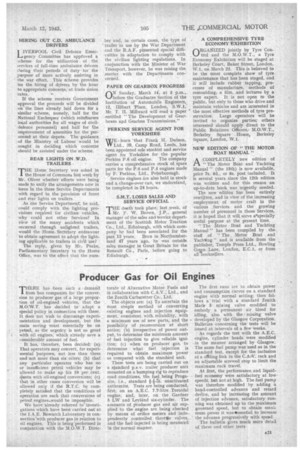Producer Gas for Oil Engines
Page 23

If you've noticed an error in this article please click here to report it so we can fix it.
THERE has been such a demand 1 from bus companies for the conversion to producer gas of a large proportion of oil-engined vehicles, that the M.O.W.T. has decided to adopt a special policy in connection with these. It does not wish to discourage experimentation and development, but the main saving must essentially be on petrol, as the urgency is not so great with oil engines; which already save a considerable amount of fuel.
It has, therefore, been decided: (a). That operators may convert, for experimental purposes, not less than three and not more than six oilers; (b) that any particular operator who has no or insufficient petrol vehicles may be allowed to make up his 10 per cent. quota with oil-engined conversions; (c) that in other cases conversion will be allowed only if the R.T.C. be completely satisfied that the conditions of operation are such that conversions of petrol* engines.would be impossible. We have Already referred to investigations which have been carried out at the I.A.E. Research Laboratory in connection'with producer gas in relation to oil engines. This is being performed in conjunction with the .M.O.W.T. Direc torate of Alternative Motor Fuels and in collaboration with C.A.V.,' Ltd., and the Zenith Carburetter Co:, Ltd.
The objects are: (a) To ascertain the most simple method of converting existing engines and injection equipment, consistent with_ reliability, with a minimum use of new parts, and the possibility of reconversion at short notice; (b) irrespective of power output, to determine the minimum amount of fuel injection to give reliable ignition; (c) when on producer gas, to determine what fuel injection is required to obtain maximum power as compared with the standard unit.
These tests are being carried out on a standard p.s.v. trailer producer unit mounted on a bumping rig to reproduce road conditions, the fuel being Progasite, i.e., standard f-t-rn. unactivated anthracite. Tests are being conducted, fiist, on an A.E.C. 7.7litre Toroidal engine, and, later, on the Gardner 5 LW and Leyland six-cylinder. The amounts of producer gas and air supplied to the engine are being checked by means of orifice meters and independently 'controlled throttle valves, and the fuel injected is being measured in the normal manner.
The first runs are to obtain power and consumption curves on a standard engine with normal setting; then follows atrial with a standard Zenith Marie 5 mixing valve modified to embody a permanent air bleed for idling, also with the mixing valve developed by the Glasgow Corporation. Bulletins concerning the tests will be issued at intervals of a few weeks.
As regards the test with the A.E.C. engine, cylinder heads were modified . in the manner arranged by Glasgow. The same fuel pump was used as in the standard test, except for the inclusion of a sliding link in the C.AN. rack and an adjustable screwed stop to limit the maximum rack travel.
At first, the performance and liquidfuel economy were satisfactory at low, speeds, but not at high. The fuel pump was therefore modified by adding a hand-controlled advance and retard device, and by increasing the amount of injection advance, satisfactory running was obtained up to the maximum governed speed, but to obtain maxi.mum power it was-etssential to increase the advance progressively with speed.
The bulletin gives much more detail of these and other tests




























































